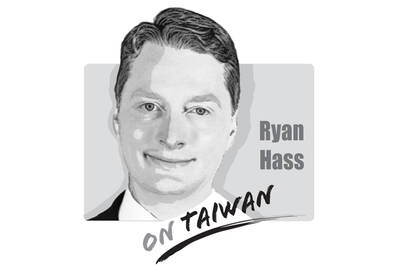Russia is facing disintegration. Although President Vladimir Putin is promoting an anti-US line to hold off this crisis, at a deeper level, Russia is not competing with the US, but with China.
Disintegration has taken forms such as Georgia's Rose Revolution in 2003, Ukraine's Orange Revolution last year and Kyrgyzstan's Tulip Revolution this year. This wave of revolutions has even hit areas within Russia, including Bashkortostan, Tatarstan, Sakha (Yakutia), Tuva (Tyva), Karelia and Kalmykija. Some of these areas are strategically important to Russia, and if they become independent, the country will break up.
For example, if Sakha becomes independent, northeastern regions like Chukotka and Kamchatka will be exposed to US influence, separated as they are from Alaska only by the Bering Strait.
The US, and to some extent Europe, is exploiting and even encouraging this situation. In fact, by permitting and encouraging certain ethnic minority regions in Russia to initiate revolutions, the administration of US President George W. Bush is doing much the same thing as the UK, Nazi Germany, the administration of former US president Ronald Reagan and other superpowers have done in the past -- namely, to weaken and divide Russia.
Russians are also aware of the imminent danger to their country. Last month, Presidential Administration Director Dmitri Medvedev, for the first time publicly admitted the danger. But this is not the whole story. The Putin administration has launched a national life-saving strategy: accelerating the concentration of power and sniping at the US by selling weapons to Syria and China, cooperating with Iran on nuclear technology and conducting joint military exercises with China this summer.
As long as Moscow pursues these tactics with sufficient determination, it can cause serious trouble for the US. But Putin is unlikely to stop the drift toward disintegration, because the current crisis is only a consequence of the disintegration of the USSR. And this disintegration was simply a case of a 20th-century party-state aberration failing to keep up with the times.
The breakup of the USSR was an expression of a party-state in crisis. It was not a solution to the crisis. Almost 10 years of a chaotic Boris Yeltsin administration could not completely uproot the party-state system. The Putin administration not only does not seek to eradicate the system, but has utilized its vestiges -- such as the Communist Information Bureau -- to establish its power while economically returning to the well-trodden path of strong state control. As a result, Russia has regained a superficial prosperity, such as its inclusion in the BRIC countries (Brazil, Russia, India and China), which are seen as leading emergent regional economies. But the agglomeration of problems that Russia continues to experience are sufficient to bring about its disintegration.
The Putin administration has made clear that unless there is a major realignment of powers -- such as that caused by World War I -- Russia's disintegration will be inevitable.
Looking at Eurasia as a whole, clearly only the disintegration of China would be sufficient to cause such a realignment and redistribution.
Russia hopes to save itself by supporting those who resist the US, and is therefore cooperating more closely with China, among other nations. But, practically speaking, Russia is not the US' equal. So while Russia may oppose the US, this will not be sufficient to hold off its disintegration. The dialectics of history mean that China is Russia's only hope; Russia can only hope that China will collapse before it does.
Chang Hsi-mo is an associate professor of the Institute for Interdisciplinary Studies at National Sun Yat-Sen University.
TRANSLATED BY LIN YA-TI

There are moments in history when America has turned its back on its principles and withdrawn from past commitments in service of higher goals. For example, US-Soviet Cold War competition compelled America to make a range of deals with unsavory and undemocratic figures across Latin America and Africa in service of geostrategic aims. The United States overlooked mass atrocities against the Bengali population in modern-day Bangladesh in the early 1970s in service of its tilt toward Pakistan, a relationship the Nixon administration deemed critical to its larger aims in developing relations with China. Then, of course, America switched diplomatic recognition
The international women’s soccer match between Taiwan and New Zealand at the Kaohsiung Nanzih Football Stadium, scheduled for Tuesday last week, was canceled at the last minute amid safety concerns over poor field conditions raised by the visiting team. The Football Ferns, as New Zealand’s women’s soccer team are known, had arrived in Taiwan one week earlier to prepare and soon raised their concerns. Efforts were made to improve the field, but the replacement patches of grass could not grow fast enough. The Football Ferns canceled the closed-door training match and then days later, the main event against Team Taiwan. The safety
The Chinese government on March 29 sent shock waves through the Tibetan Buddhist community by announcing the untimely death of one of its most revered spiritual figures, Hungkar Dorje Rinpoche. His sudden passing in Vietnam raised widespread suspicion and concern among his followers, who demanded an investigation. International human rights organization Human Rights Watch joined their call and urged a thorough investigation into his death, highlighting the potential involvement of the Chinese government. At just 56 years old, Rinpoche was influential not only as a spiritual leader, but also for his steadfast efforts to preserve and promote Tibetan identity and cultural
Strategic thinker Carl von Clausewitz has said that “war is politics by other means,” while investment guru Warren Buffett has said that “tariffs are an act of war.” Both aphorisms apply to China, which has long been engaged in a multifront political, economic and informational war against the US and the rest of the West. Kinetically also, China has launched the early stages of actual global conflict with its threats and aggressive moves against Taiwan, the Philippines and Japan, and its support for North Korea’s reckless actions against South Korea that could reignite the Korean War. Former US presidents Barack Obama